2020 Toyota Yaris Hybrid review
The Yaris has long been the smallest, most affordable car in the Toyota lineup. That is still the case, but the all-new five-door hatchback released in August 2020 is a lot less affordable than its predecessor was.
A hefty 44 percent price hike means the base Yaris Ascent Sport is now $22,130 (plus on-road costs), putting it within range of the one-size-larger Corolla ($23,895).
The Yaris also includes a hybrid variant for the first time, although Toyota previously had the Prius C that was effectively a Yaris with unique styling and a different name. The Yaris C has now been discontinued.
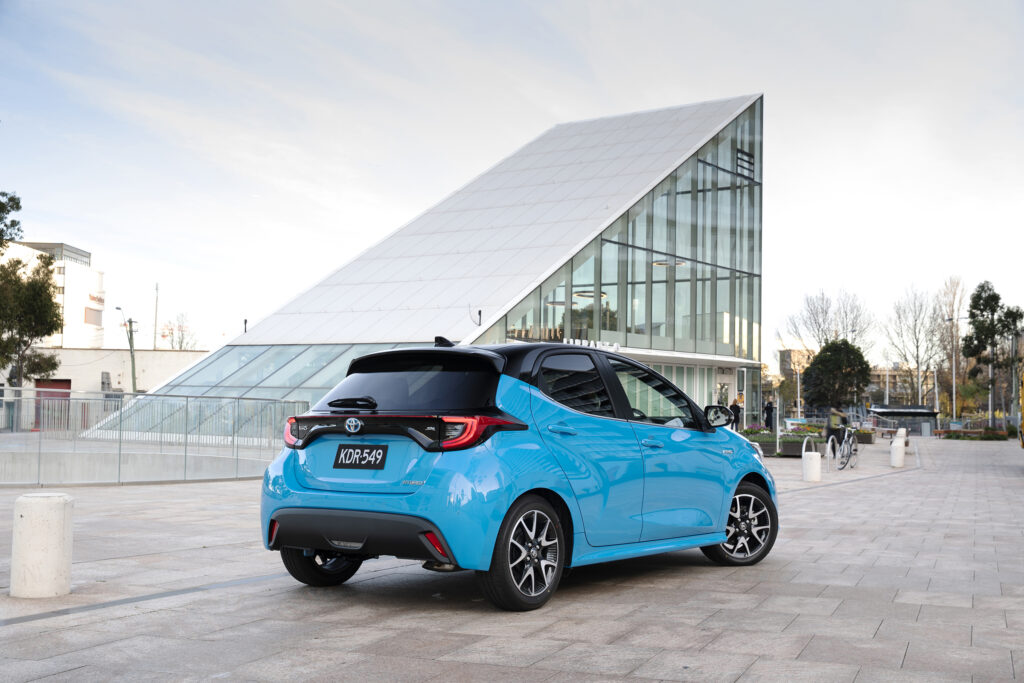
But the Yaris is also a trailblazer, at least for Toyota. Whereas all other EVs and hybrids now use lithium-ion batteries, the Yaris is the first Toyota Hybrid using lithium-ion (other Toyota hybrids use nickel-metal hydride batteries). Expect more to make the switch soon, the next one being a soon-to-be-updated Camry Hybrid.
Value
Toyota’s hybrid push has included some big surprises on the pricing front.
But for the Yaris it’s a surprise in the wrong direction.
That’s because the most affordable Yaris Hybrid is the SX, priced from $29,020, plus dealer and on-road costs.
That makes it more expensive than the most affordable Corolla Hybrid ($27,395), which is bigger and has more power. Go figure…
Want the latest EV news and reviews delivered directly to your inbox?Subscribe to our weekly newsletter!
Toyota argues it’s because the cheapest Yaris Hybrid is based on the mid-level SX (there’s no Yaris Hybrid Ascent Sport, for now anyway), whereas in the Corolla you can get the hybrid paired with the entry-level model.
Still, it doesn’t hide the fact the Yaris Hybrid represents a $2000 price premium over a non-hybrid Yaris with identical equipment (in the Corolla the hybrid price premium is $1500).
Speaking of equipment, the Yaris is far more generously appointed than previously, which partially helps it live up to its premium positioning.
Standard gear includes a 7.0-inch touchscreen with Apple CarPlay and Android Auto, digital radio tuning, auto high beam and active cruise control.
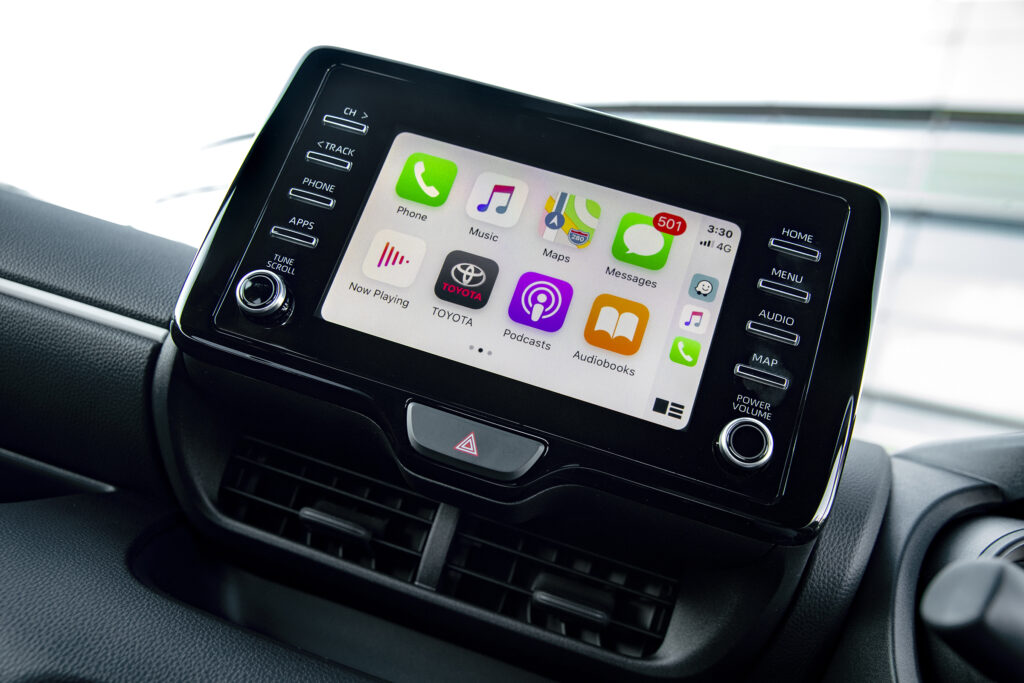
Safety is well catered for too, with eight airbags, including class-first centre airbags that pop out of the centre bolsters of the front seats to protect occupants from banging heads. There’s also auto emergency braking (AEB), traffic sign recognition and lane keep assistance.
In that mid-level SX Hybrid trim there’s also 15-inch alloy wheels, smart key entry, satellite-navigation, lightly tinted windows and automatic air-conditioning.
If you want more fruit there’s a Hybrid ZR that sells from $32,100 plus on-roads (expect to pay something like $35K).
It picks up 16-inch alloy wheels, blind spot monitoring, head-up display, parking sensors at either end, a rear spoiler and some trim and colour changes, including black interior surrounds and red highlights.
Inside
The Yaris is a big step up in interior presentation, although that only brings it in line with others in the city/light car class, such as the recently-updated Mazda2. The Volkswagen Polo is arguably still a step above on that metric.
Plastics are of a higher quality and more thought has gone into the layout.
Having dials and buttons surrounding the touchscreen also makes darting between menus and adjusting the volume a lot easier.
While there’s a traditional lever-operated handbrake, the instrument cluster is digital, with two large circular highlights incorporated within. Combined with the three-spoke steering wheel it suits the character of the Yaris.


Our preference was for the darker seat trim of the SX over the light grey of the ZR (slide the bar on the image above to compare). That said, the ZR’s red highlights add some spice to the dash and other areas.
Front seat space is thoroughly generous, although the cabin is quite narrow. That means wider elbows may come into contact when two people are alongside each other.
There is no covered console, instead storage pockets are open. Combined with sizeable door pockets and useful binnacles built into the dash, they provide ample space for phones and extras.
Those in the rear are crunched on legroom, particularly if the person up front wants to spread out. And in-line with rivals there are no air vents out back. But back-seat headroom is respectable considering this is a compact hatch.

Similarly, the boot is compact but useful, aided by a 60/40 split-fold seat. Its 270-litre capacity is identical to the non-hybrid Yaris.
Performance and efficiency
The Yaris is Toyota’s first hybrid that uses a three-cylinder petrol engine instead of a four-cylinder.
The 1.5-litre unit is the same basic engine used in the non-hybrid Yaris, but it’s been tuned to the so-called Atkinson cycle that focuses on efficiency over outright power.
Whereas the regular Yaris makes 88kW of power and 145Nm of torque, the same engine in the hybrid versions makes 67kW/120Nm.

However, in the hybrid there’s also a 59kW/141Nm electric motor helping out.
Combined peak power output is 85kW (Toyota doesn’t quote a combined torque output).
All of which adds up to thoroughly respectable performance.
And it’s the electric motor that makes the Hybrid such a useful device around town. Initial throttle applications are rewarded with an effortless surge, one quickly accompanied by a minor rumble as the petrol engine chimes in.
The e-motor provides a generous low-rev boost that gives the Yaris Hybrid better around town performance than expected from a three-cylinder engine.
It’s more strained at higher speeds where the modest petrol engine power and additional 45-odd-kilograms of the hybrid system take the edge off acceleration. But in its typically suburban environment the Yaris zips along nicely.
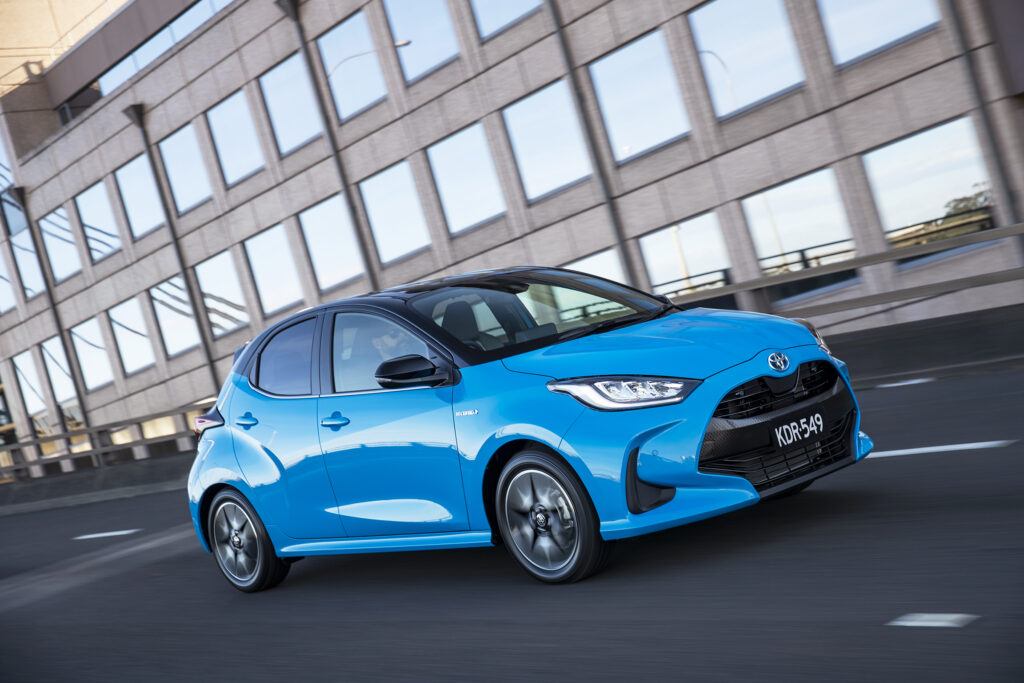
It’s also impressively frugal with a fuel tank that’s pleasingly difficult to drain; expect close to 1000km from the 36-litre capacity.
Claimed fuel-use is just 3.3 litres per 100km, and our experience suggests it’s a very achievable figure. Less achievable is the city fuel-use claim of 2.8L/100km, but it’s an admittedly tough target.
Even driven at freeway speeds and driven enthusiastically around town it’s difficult to use any more than 4.0L/100km.
That it only needs the cheaper regular unleaded fuel cements the Yaris Hybrid’s place as among the cheapest cars to run.
Even the servicing is respectably affordable. The first five scheduled services are capped at $170 each and are performed every 12 months or 15,000km.
Charging
No charging goes on with any Toyota hybrids in Australia. They are all powered purely by petrol.
The new lithium-ion battery pack is tiny anyway, with a capacity of just 0.76kWh, or 763.7Wh.
Instead, the battery receives its charge from regenerative braking, which is where the flow of electrons in the electric motor is reversed to act like brakes. It allows energy normally lost through heat in the brakes to be sent back into the pack as electricity.
Ride and handling
Much of the tinniness of former Yaris generations has been serious diluted with the latest iteration.
There’s a solidity and competence that shows genuine maturity in the core architecture. Good to see the bigger price tag has had an impact beyond the list of features!
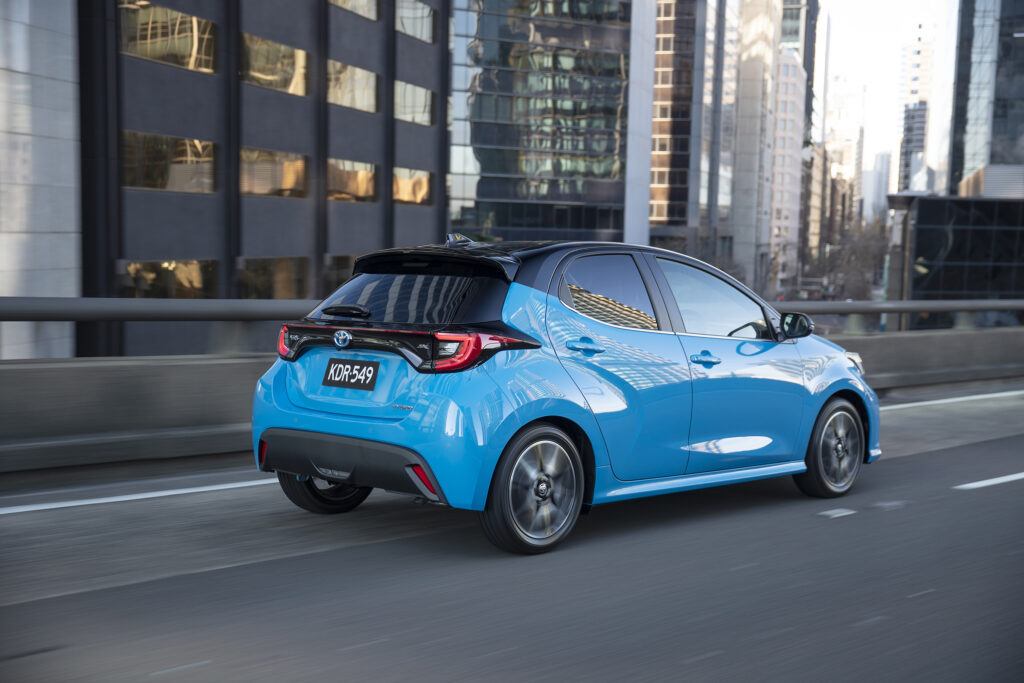
Steering is light but predictable, the suspension compliant for its typically suburban duties.
There are clearly limits to its talents. Tyres have been chosen for fuel economy, so if you lean on them heavily in a corner they’ll protest with a yelp.
Fortunately it’s all very predictable and the electronic stability control acts as a final helping hand to bring things back into line.

Unsurprisingly the Yaris does its best work around town. The compact body is a snip around tight streets and when parking.
Noise levels are respectably low and there’s enough core competence for those country cruises.
Talking point
There’s an EV mode but don’t get too excited. The owner’s manual suggests there’s a maximum electric-only range of only 1km (yep, a single, miserable kilometre…) and that it could be as little as a few hundred metres.

Then the manual lists a whole bunch of scenarios in which the EV mode won’t work. They include when the battery is low on charge (typically below about half its capacity), when the battery exceeds 32 degrees Celsius and when the speed is too high (typically over about 50km/h).
So the EV mode is really only useful for ducking in and out of the driveway silently. And even then, only sometimes.
Really, the electrical drive system is about saving fuel, something it does incredibly well.
Safety
Much of the asking price for the Yaris goes towards safety gear, both active (crash avoidance) and passive (protecting you during a crash).
It’s the first sub-$100K car to get front centre airbags. Popping out of the centre side seat bolsters they’re designed to stop those up front bumping heads in a side impact. Expect more front centre airbags in future to meet tougher ANCAP crash regulations.
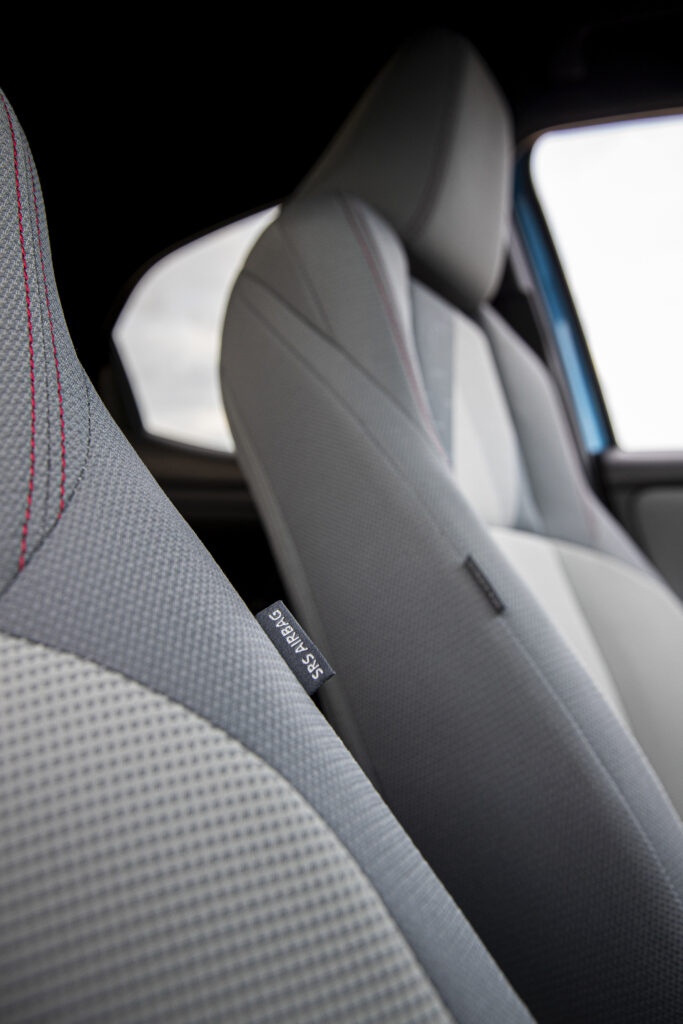
The Yaris also gets another six airbags (for eight in total) and a body structure that is expected to earn it a five-star ANCAP rating.
There’s also a healthy bundle of crash avoidance systems, headlined by autonomous emergency braking to apply the brakes if the driver doesn’t. That AEB system incorporates a secondary braking system to help slow or stop the car after the first impact.
Lane keep assistance and traffic sign recognition is also included.
Plus there’s “turn assistance” for intersections designed to minimise impacts with pedestrians and other vehicles.
Verdict
There’s nothing wrong with the core of what the Yaris does. It’s a city-friendly compact hatchback that is enjoyable to drive and beautifully suited to the suburbs.
The biggest issue it will find on its path to mass acceptance is the price. Costing more than a Corolla Hybrid makes it a tough recommendation, especially considering the Corolla dishes up more of everything (space, performance, comfort, etc).
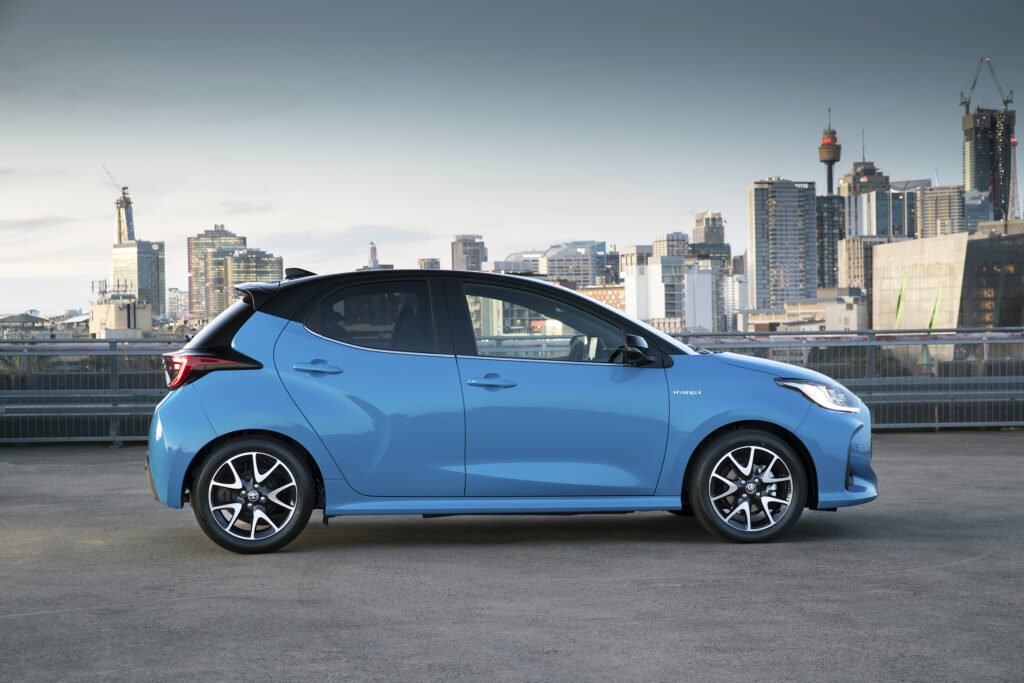
That said, those wanting a small city car with equally diminutive running costs will have little to complain about with Toyota’s latest hybrid.
It’s loaded with tech and safety and sneaks around corners confidently. In terms of drivetrain response the Yaris Hybrid is also significantly more enjoyable than the garden variety Yaris.
2020 Toyota Yaris Hybrid specifications
Price: $29,020 (SX), $32,100 (ZR), plus on-road costs
Basics:Hybrid, 5 seats, 5 doors, city hatchback, FWD
Range: 0-1km
Battery capacity: 0.76kWh
Battery warranty: 7 years/unlimited km
Fuel consumption: 3.3L/100km
Engine: 1.5-litre 3-cylinder, 67kW/120Nm
Motors: 1 front 59kW/141Nm (85kW combined peak power)
AC charging: NA
DC charging: NA
0-100km/h: NA

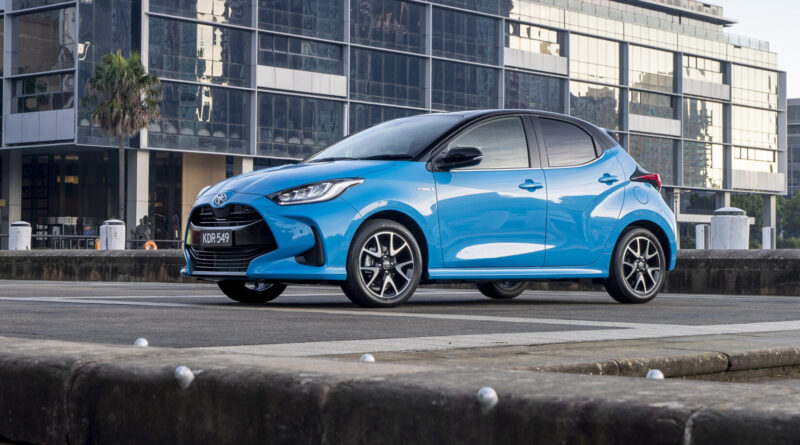
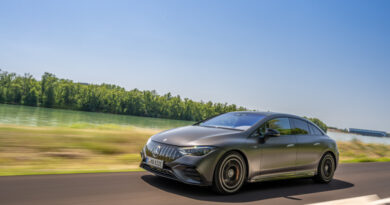

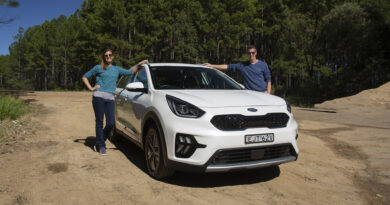
Good review Toby, but you did not mention that it has drum rear brakes ! This is 2020 not 1980 Toyota. So, a massive price rise and cost cutting on safety.
Good point!